|
|
Post by JohnH on Feb 28, 2014 15:42:00 GMT -5
This thread is to illustrate how a normally-wired tone control rolls off treble, stage by stage as you turn the knob.
What we would probably want is a even spacing of traces from 10 down to 0, suggesting a smooth even taper. The charts show the following combinations:
1. single coil pickups with 250k pots for volume and tone
2. as above, with a 500k tone pot, and 250k volume
3. Single coil with 250k linear pot, and 250k volume pot
4. PAF humbucker with two 500k log pots
Other than the linear test, the pots have a 10% value at mid turn and tone caps are all 22nF. Volume pots are all at maximum. There are dashed lines to show the extra increment that can be had at '10' if the pot is a no-load type.
1. Single coil pickups with 250k pots for volume and tone
This shows quite a nice spread up to 5, then the pot changes to a steeper slope and the tone changes faster between 5 and 6, slows down as it gets to 10, then jumps about 4db if it is a no-load pot
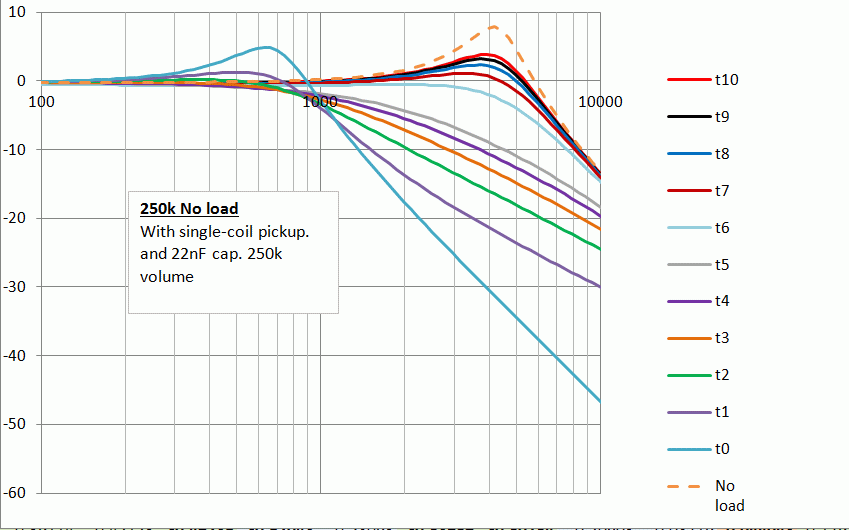
2. Single coil pickups with 500k tone pot, 250k volume pot
This has the same overall range (if you include no-load), but everything is moved up, as expected. It also has a wide gap between 5 and 6, but a bit less than with the 250k tone. The step up to no-load is smaller.
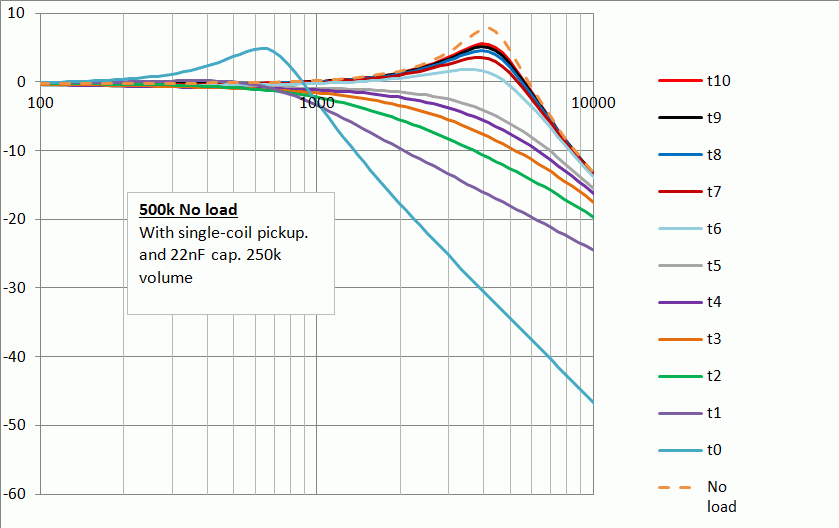
3. Linear tone pot -with single coil pickup
This shows why we don't normally use linear pots as tone controls. All the action happens in the lower settings, and not much at all above 5. Both volume and tine are 250k pots:
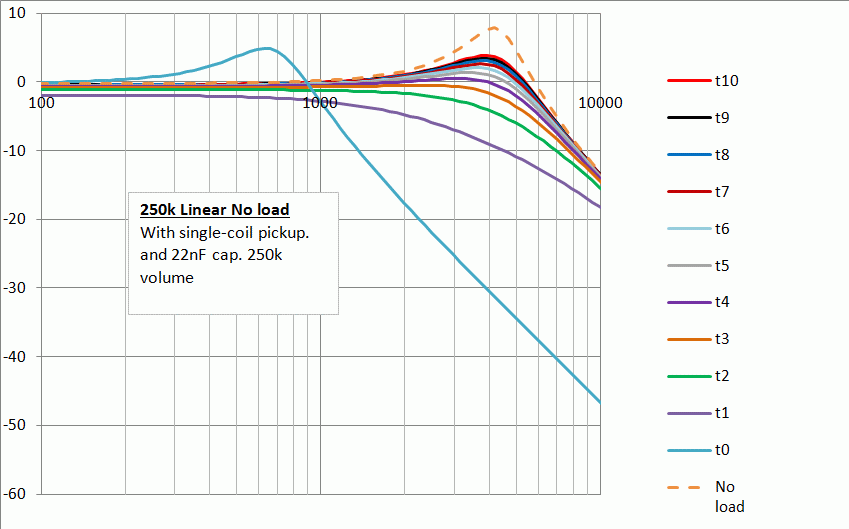
4. 500k pots, with PAF humbucker
A reasonable spread from this combination, with a strong no-load boost. It also has the wider spacing between 5 and 6.
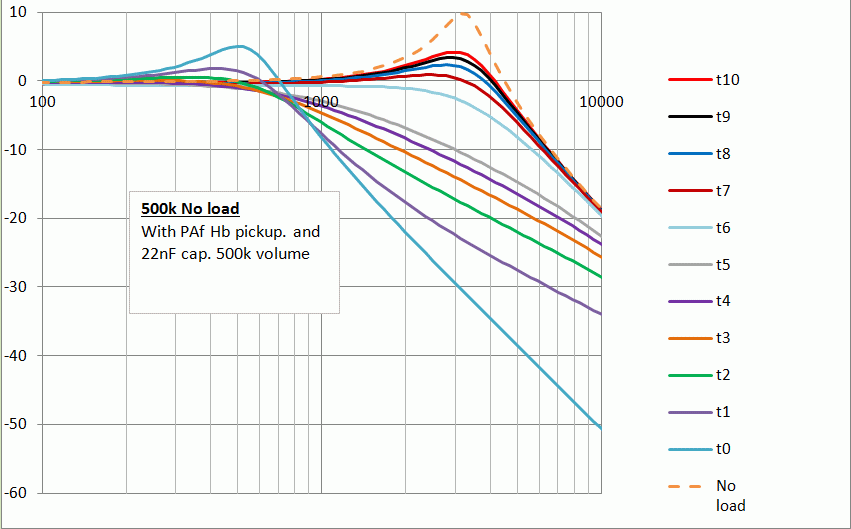 |
|
|
|
Post by Yogi B on Dec 14, 2016 0:16:01 GMT -5
Other than the linear test, the pots have a 10% value at mid turn It might be worth noting that it is not uncommon for the 'standard' logarithmic taper of "import" potentiometers to have 15% of the total resistance at the midpoint of rotation, i.e. they are slightly closer to a linear taper thus slightly less suitable for tone controls. Additionally I don't wish to hijack this thread, but in my recent effort to resolve the love-hate relationship I have with the 'dial of darkness' -- the thing that brought me back to this sub-board -- I've had two repeating questions: (A) Why physics? (Every time that I wish that the ratio of capacitance/volume for variable capacitors was at least about three and a half orders of magnitude larger) and perhaps more seriously, (B) Has anyone heard of (or even had experience with) using a 5% log taper pot as a tone control in order to get the brightness of say 500k Ohm pot combined the a sweep similar to that of a 250k Ohm pot, that is if the 5% log taper is something that doesn't only exist on data sheets? Or would the advice to go no-load instead, or maybe something like a 250k no-load pot in parallel with a 500k resistor? |
|
|
|
Post by JohnH on Dec 14, 2016 3:13:54 GMT -5
If A is about variable capacitors, its impractical to create more than very low values out of physical parts. The traditional units used on old radios were a two groups of interleaving plates either rotated apart (low cap) or brought together (higher cap). But they are limited by how close you can build moving parts without touching so that there is an air gap and no short circuit. Capacitance increases the closer two conductors are to each other. The distances between plates that would create the values we might want would be infeasibly small. Fixed capacitors, apart form having no moving parts, have conductors separated by a dielectric material that is more effective for this purpose than air, and so can be micros apart and get a significant fixed capacitance in a small volume.
Never seen a 5% pot, but nothing is impossible about it. I think a no-load pot is great for a tone control and, as you suggest, if the step to infinity at 10 is too much, you can put a fixed 500k in parallel. I had some success with opening up pots and 'stretching' the resistance by scraping the edges of the track to increase resistance. I managed to get a 400k pot (supposed to be 500k) up to about 700k if I remember rightly.
|
|
|
|
Post by newey on Dec 14, 2016 6:06:05 GMT -5
JohnH-
As ChrisK once said, log pots are not truly logarithmic, but a "piece-wise approximation". Does your model account for this, or does it assume an idealized log curve?
Just wondering how close to reality we can get here.
|
|
|
|
Post by JohnH on Dec 14, 2016 8:56:36 GMT -5
The plots from the log-taper pots modeled here are all based on a bi-linear assumption, with 10% at mid turn. Ie they nominally match a real pot, though actual real pots may vary further.
|
|
|
|
Post by Yogi B on Dec 14, 2016 13:23:27 GMT -5
A is about variable capacitors Yes it is, and I'm already aware of their limitations. I had also wondered if this was a valid approach, I may have to give it a try. log pots are not truly logarithmic, but a "piece-wise approximation". Does your model account for this, or does it assume an idealized log curve? The the recurring larger gap between 5 and 6 is somewhat of a giveaway of the piecewise approximation as it's (partially) caused by the sudden switch to the steeper gradient from 5 onwards. The whole business of log isn't actually log means that I have 4 different types of logarithmic potentiometer that I use for simulations with SPICE: - An actual logarithmic taper, that doesn't go to zero resistance at fully counter-clockwise, i.e a N% log taper only goes down to (N%)2, or Rpercent = Rtap (1-Wiper)/(1-Wtap)
- An adjusted logarithmic taper, the above scaled and offset vertically such that it does actually reach zero
- An Exponential based curve, a slightly different approach which is similar to (ii.) but is steeper around the midpoint (or actually Wtap) of it's sweep, given by Rpercent = Wiper log(Rtap)/log(Wtap)
- Finally various table based models based on real world measurements of physical pots
|
|
|
|
Post by sumgai on Dec 15, 2016 13:13:22 GMT -5
A is about variable capacitors Yes it is, and I'm already aware of their limitations.
Limitations, shmimitations.
Ya know, I don't often stick my oar in the water too much anymore, but this time I'm gonna pull a ChrisK....
It's good once in a while to step away from one's own workbench, and go visit someone else's workbench. Here's an example of why that's a good idea:
In the electronics world, there is such a thing as a switched capacitor. In essence, this device acts as a variable capacitor, and can be idealized for a great many purposes, depending on the end goal. Schematic-wise, it looks like this:

You can easily breadboard this setup, but it won't be practical. The idea here is that you limit the time allowed for the capacitor to charge up, and you limit the time permitted for discharge. Obviously, this has to be done in a very steadily repeatable fashion. That's where clock circuits come into play - they send a signal to do the actual switching, you as the designer simply tune the clock to the desired frequency, and that sets the capacitance. Almost equally obviously, the clock need not be cast in stone, it can indeed be varied at the designer's whim. And VOILA! we have a variable capacitor.
Instead of going all Engineer on you, directly at least, I'll just refer you to some pages of explanation, fairly close to layman's terms:
The ubiquitous WIKI
A college level introduction
and for the masochists amongst us (PDF file);
The final word, from the inventors themselves
And now a word from our sponsor;
I started out just the same as all of you - so traumatized at birth, I couldn't stop screaming for about a year! Fast forward to this day and age, where digital circuitry opens up a whole new world, one that leaves the analog world of my birth way behind.
Now that's not to say that we guitarists are doing it wrong - indeed, we're doing it cheaply, which is the reality faced by most of us. Digitally replacing a bone-stock component such as a capacitor is not inexpensive, but it does allow us a universe of new possibilities in tone control. The major downside, besides expense, is that we'll now need to power this thing, so a battery will be added to the guitar's body. But battery life will be measured in months, not hours - digital is most often cheap to power, unlike analog circuits. That's an effective cost we can appreciate, I'm certain.
Is analog the only way to go? Should we eschew digital circuitry for the sake of The Mojo Tone? That's up to the individual player/user/owner, not me. And for the record, I've not done anything to my own axe along these lines, I'm perfectly happy with the way Leo designed it, back in 1957 and '58. But if you aren't satisifed, then perhaps you should take a gander at the above... it might give you a Nutzy idea that will explode the world of control available to guitarists - who knows? 
HTH
sumgai
|
|
|
|
Post by Yogi B on Mar 7, 2018 23:44:40 GMT -5
It's only 1.23 years later... The major downside, besides expense, is that we'll now need to power this thing, so a battery will be added to the guitar's body. Whilst I can't say I completely avoid on-board electronics, those guitars with such things are probably my least played nowadays. Generally I'll only plump for active when I couldn't otherwise achieve what I wanted. In this case of variable capacitors, whilst not infinitely variable a 12 position rotary switch is close enough.
This topic isn't really about variable capacitors, it's about pot tapers or specifically: And it's my feeling that a 'logarithmic' taper isn't the best thing suited to that, even if it were an actual smooth 5% logarithmic taper. As you say:Log pots are common and widely available in various guitar applicable versions since we tend use them as volume controls -- for tone controls it's a case of we want something non-linear and a log taper happens to be roughly the correct shape, so it'll do. What I think would be a better fit is a reciprocal taper. Here's a comparison of various log tapers for comparison and my take on a reciprocal taper: | True log 10% | | True log 5% | | CTS log (~10%) | | Alpha log (~15%) | | Reciprocal (~8%) |
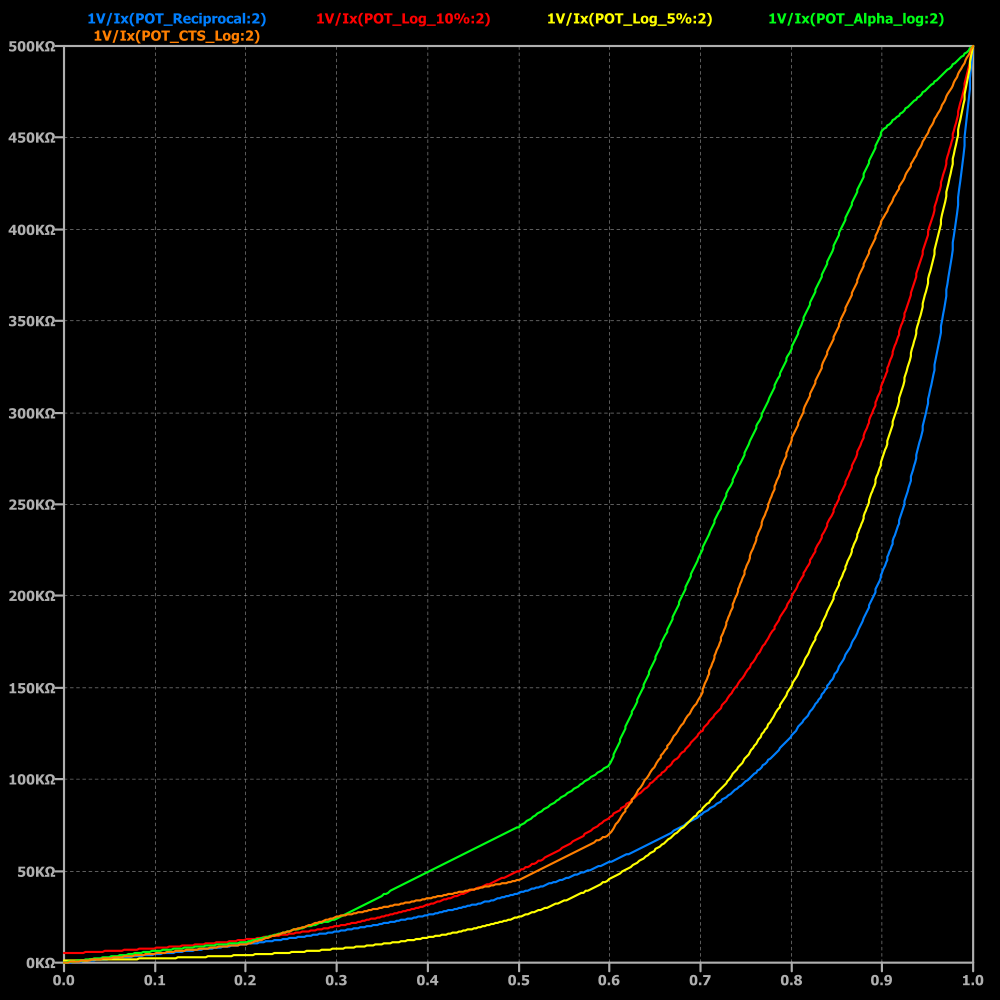 Note how the CTS 'log' taper is at least pretty close to the true 10% taper from 0 up to about 7, before it starts increasing in resistance too soon. Then look at the reciprocal taper which has comparable resistance values even later. I believe that this will help combat the issue of tone controls doing little in the upper half of their turn, thus produce a more natural sounding roll off across the range of the whole pot.
One of the reasons it's been so long replying to this was that I decided LaTeX would be a better medium for running through the maths of pot tapers. Then I got sidetracked explaining pot tapers in general, then further sidetracked thinking about what parameter a tone control is actually trying to make linear in the first place. As such it never really got anywhere, but if anyone's interested I'll see what I can salvage. |
|